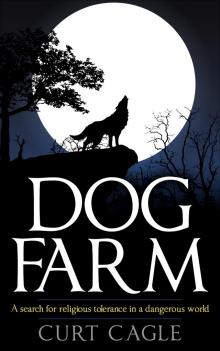


Dog Farm: A Search For Religious Tolerance In A Dangerous World
Curt Cagle

DOG FARM
A search for religious tolerance in a dangerous world
CURT CAGLE
Table of Contents
Prologue
Chapter 1
Chapter2
Chapter 3
Chapter 4
Chapter 5
Author Commentary
Other Books by Curt Cagle
Prologue
The stream that coursed through the meadow of yellow flowers was cool and clear. It was brisk along its entire course until the point at which it grew wide and slow, at the pasture near the access road. The wooded hills beyond the grass covered expanse were beautiful. A cold and clear artesian well fed into a small pool of water before the overflow traced a ribbon of water to meet the stream. It was a picturesque site, and had been that way for many years; ever since Thomas Runyon purchased the land.
He knew it was special the first time he saw it. Mr. Runyon was a successful Wall Street fund manager until he retired early at age 50. He had made his mark but had burned out on the lifestyle. That’s when he began to indulge himself into philanthropic endeavors. He never married and he had no children, but spent a good portion of his money on a poodle named Riley. Riley was a rescue dog and the love they shared inspired Mr. Runyon to purchase those beautiful 600 acres in the country where he and Riley would go to relax and have fun.
After Riley passed away at the ripe old age of twelve, Mr. Runyon decided to honor the dog by turning the acreage into a dog farm, where strays would be welcome and unwanted dogs like Riley could find a home. A barn was built and a circumferential fence was erected around the acreage. He acquired his first canine residents with a call to the largest animal shelter in the county and arranged for the delivery of every dog they had. From those modest beginnings, word spread about the dog farm. He was featured in several large publications and twice was featured by a national television news service. The dog farm grew exponentially. There was plenty of room and there were few complaints.
At first, Mr. Runyon hired people to feed and make sure the dogs were taken care of, but good help was difficult to find and besides, he loved being there more with every visit. Eventually, he did most of the work himself. Later, when his body began to degrade in its ability, he brought in volunteers to help from the small, private university on the far side of the county. The young students came and went as their time at the school did the same, but Mr. Runyon was always there. As he grew old, the dog cemetery on a hill inside the fenced acreage continued to expand, as dogs would live out long, happy, and healthy lives at the farm.
The day came when Thomas Runyon passed away. He was eighty years old at the time of his death and was laid to rest far away, alongside his parents in the town where he was raised. Mr. Runyon had spread his money to many places. One of those was the school, but it came with a contingency. The school would only be able to take monthly monetary installments from a huge trust, if it agreed to continue the tradition of service by the students to the dogs. In Mr. Runyon’s mind, it not only funded the school, but it gave the youth a much needed lesson in the care of something other than themselves. The young people at the school continued their work at the dog farm. That may have been out of the goodness of their hearts or it may have been because the university came to require of all students, a semester of service at the dog farm as a credit in animal husbandry.
His death was thirty years ago. While there remained a statue erected in his honor at the school, the young men and women only saw it as a tarnished perch for pigeons to destroy. The students continued to take care of the barn, and took delivery of the rations if they remembered to order any, but only a scarce few seemed to really care about the place. Most did as little as possible to earn their mandatory credit. The farm was 50 miles away from the school, which certainly didn’t help. Even the school found a way to give out the credit in return for watching an orientation video and writing a report on the care of dogs, for those students who had a hardship in travel. As a result, the property had fallen into disrepair, and seldom was someone from the university to be seen.














